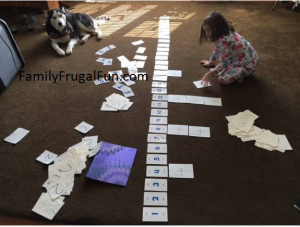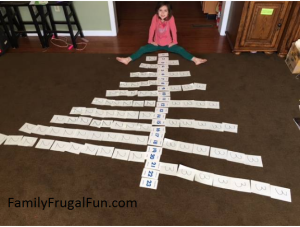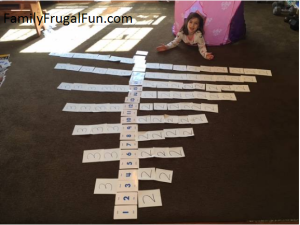
Home School Math Programs (division and multiplication)
If you are like me, you probably don’t like the rote memorization that is taught in most schools today. Math can be a hard concept, but it can be even more difficult when children don’t “see” the purpose behind it. Instead of forcing my child to memorize all her multiplication facts with flash cards, we came up with a fun, yet simple way for her to learn multiplication facts using patterns, scrap paper, and a pencil! These simple home school math programs are so much more fun for students! Here’s what you do:

Create a Number Line
You can use scrap paper for this, or note cards. Write 1-10 (or however far you want to go up – I generally go up to 25) on separate pieces of paper. Line them up from 1-25 on the floor. If you want it to be more challenging, you can make your number line go up to 150 or more.
Create your Pieces:
You don’t have to create each group of numbers all at once if you don’t want to (you can start slow with 2’s and 3’s your 1st week then add 2 on each week if you like), but here is what you will need for your child to start practicing times tables up to 10 or more: (if you wanna go further up to say 25 then just increase your #’s below)
- Twos: You will need 15 pieces of paper all with the number 2 on them.
- Threes: You will need 6 pieces of paper all with the number 3 on them.
- Fours: You will need 3 pieces of paper all with the number 4 on them.
- Fives: You will need 3 pieces of paper all with the number 5 on them.
- Six through 10: you will only need 1 piece of paper with each number on them.
If you want to make it a little more challenging, do 15 pieces of paper for each number (15 twos, 15 threes, 15 10s etc.).

How to Play:
This game is really quite simple. Your child is basically just counting, but will eventually get to that “aha” moment where they realize the pattern and how addition relates to multiplication. You don’t teach this pattern because your child will learn it by default.
- Lay your number line out: Lay out your number line across the floor starting with 1 and going in order to as far as you want.
- Start with the twos: Give your child the stack of twos and tell them they have to put their twos in order. So, they start with one 2 (what is 2+0=2) and lay that 2 under the 2 on the number line. Then they have to take two 2s (what is 2+2=4) and they lay two 2’s under number 4 on the number line. Your child will count out three 2’s next and continue this pattern until there are no 2’s left.
- Remove the twos from your number line: You will need to remove your twos from the number line or have your child work on the other side of the number line as they move on. (see image above – we did 2’s on one side then 3’s on the other)
- Next, do the threes: Once your child has mastered this, move on to the three’s. Start with one 3 (what is 3+0=3) and lay one 3 under the 3 on the number line. Have your child pull 2 threes from the stack (what is 3+3=6) and place both of them under the 6 on the number line.
- Continue this pattern: Continue the pattern with each stack of numbers you have. Your child will soon realize the pattern that every 2nd number is where twos go and every 3rd number is where three’s go. (so forth and so on)

This home school math program allows your child to learn their multiplication facts visually, mathematically, and kinesthetically. When more parts of the brain are used to do learn one skill, the skill gets mastered quicker and easier! Additionally, they’ll see that math is a pattern – KIDS HAVE A HARD TIME LEARNING THIS PATTERN WITH MEMORIZATION METHODS! Once they understand the pattern (they’ll see it by default with a few simple questions on your part) learning times tables will become much easier and not a chore anymore.
Questions to ask:
- Do you see a pattern?
Can you could the odd numbers on your time line?
Can you could the even numbers on your time line?
How many 2’s go into 10?
How many 2’s go into 14?
Then, after you’ve mastered multiplication, division is simply a matter of doing the same numbers and time line and asking a different question. They’ll quickly see that they now magically understand division because the cards are laid out right in front of them.
- What is 10 divided by 2?
etc …..
What other multiplication tips do you have?


I am SO DOING THIS.
I made up this system myself and you can start it with kiddos as young as Kindergarten or 1st grade. It’s based on patterns instead of boring memorization (which kids dread) Hope you’re doing well Joy and that our paths cross again soon!!!!!